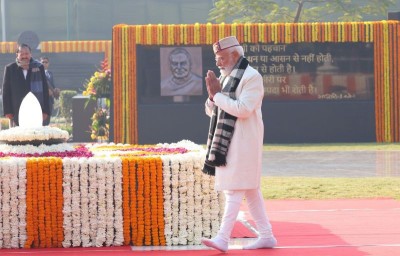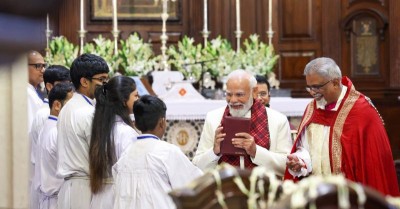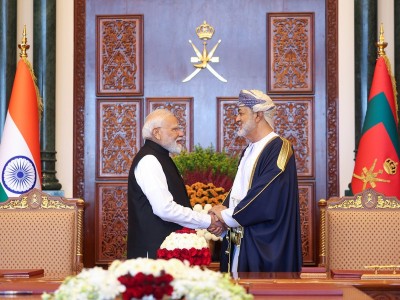
Jharkhand: Increasing Volatility
On April 4, 2017, two youth, identified as Birsa Purti (25) and Bandeya Munda (22), were shot dead at Toner village under Murhu Police Station in the Khunti District of Jharkhand. Police claimed that Bagrai Champia, an 'area commander' of the PLFI, was involved in the twin killings. However, the reason behind the killings is yet to be ascertained.
On March 27, 2017, PLFI cadres killed a civilian, David Soy (20), outside his house in Gompilla under the Torpa Police Station in Khunti District. They suspected him of being a 'police informer'.
On March 24, 2017, three cadres of the Tritiya Prastuti Committee (TPC), another splinter group of the CPI-Maoist, were killed in an internecine clash at Seeta Chuan under the Mohammadganj Police Station in Palamau District. One of the killed TPC cadres was identified as 'zonal commander' Ajay Yadav, carrying a reward of INR 500,000 on his head. The other two killed were identified as 'area commanders' Krishna Kharwar and Ravindra Mahto. Police recovered one AK-47 rifle, one INSAS rifle, one semi automatic rifle, one .303 rifle, along with 630 live bullets, 23 magazines, 11 cell phones, several Improvised Explosive Devices (IEDs), 50 meters of Codex wire, and six back packs.
On March 20, 2017, a group of CPI-Maoist cadres killed a teacher, identified as Charku Yadav aka Sandip Yadav (30), at Jori village in Gumla District. CPI-Maoist cadres also left a pamphlet which labelled Yadav a 'police informer'.
According to partial data collated by the South Asia Terrorism Portal (SATP), at least 22 persons, including 13 civilians, two Security Force (SF) personnel, and seven Left Wing Extremists (LWEs), have been killed in LWE-linked incidents in Jharkhand in 2017, thus far (data till April 9, 2017). During the corresponding period of 2016, there were 30 such fatalities (seven civilians, seven SF personnel, and 16 LWEs).
The spike in fatalities among civilians in the recent past is worrisome. Civilian fatalities through 2015 stood at 16, the lowest number of such fatalities recorded in the State during the course of a year since the formation of the CPI-Maoist on September 21, 2004. The number doubled, at 32, in 2016.
Though no fatality has been registered in the SF category so far in the current year, SF fatalities had also doubled to 10 in 2016, as compared to five in 2015. Significantly, as in the case of civilians, 2015 had recorded the lowest ever fatalities in the SF category since the formation of the CPI-Maoist. A previous low of six SF fatalities was recorded in 2007.
Though the number of militants killed increased from 37 in 2015 to 40 in 2016, there was a significant dip in the kill ratio achieved by the SFs, which dropped to 1:2 in 2016, from 1:5 in 2015. Out of 37 LWEs killed in 2015, at least 25 were killed by the SFs, while 12 were killed in internecine clashes. Similarly, out of 40 LWEs killed in 2016, at least 20 were killed by the SFs while remaining the 20 were killed in internecine clashes.
Overall fatalities in 2016 increased by 39.65 percent, as compared to 2015, from 58 to 81. Overall fatalities in 2015 were the lowest to be recorded in the State since 2006, when they were 94.
Unsurprisingly, other parameters of violence in the State also registered a significant surge in 2016. According to SATP data, the state recorded at least eight major LWE-linked incidents (each involving three or more killings) resulting in 36 fatalities, including 10 civilians, seven SF personnel and 19 LWEs in 2016, as compared to three such incidents in 2015, resulting in 18 fatalities, including three civilians and 15 LWEs. LWEs also triggered at least 12 bomb blasts in the State in 2016, as against seven such incidents in 2015. Further, the Maoists gave bandh (total shut down) calls on 11 occasions in 2016, as compared to six such bandh calls in 2015.
The number of Districts from where killings were reported also increased through 2016 as compared to 2015. Out of a total of 24 Districts in Jharkhand, fatalities were reported from 13 in 2016: Gumla(14); Khunti and Palamu (13 each); Ranchi and Latehar (11 each); Giridih and Simdega (four each); West Singhbhum (three); Bokaro, Hazaribagh and Lohardaga (two each); and Chatra and Seraikela-Kharsawan (one each). 12 Districts recorded such fatalities in 2015 - Palamu (15); Khunti and West Singhbhum (six each); Gumla and Hazaribagh (five each); East Singhbhum, Lohardaga and Ranchi (four each); Latehar (three); and Chatra, Giridih and Godda (two each).
Another dimension of concern is the fact that activities of Maoist splinter groups also increased through 2016. The prominent among these include PLFI, TPC, Jharkhand Prastuti Committee (JPC), Jharkhand Sangharsh Jan Mukti Morcha (JSJMM), and Jharkhand Jan Mukti Parishad (JJMP). Out of the 31 civilians fatalities recorded in 2016, while 14 civilians were killed by the CPI-Maoist, 16 were killed by these various groups - 12 by PLFI, two by JPC, and one each by JJMP and TPC. One civilian was killed during cross firing between CPI-Maoist and PLFI. All the 10 killings in the SF category were, however, carried out by CPI-Maoist. The 40 LWEs killed belonged to four groups - PLFI (18), CPI-Maoist (15), JJMP (three), TPC (three), and JSJMM (one). In 2015, CPI-Maoist was responsible for all the 16 civilian and five SF personnel deaths. 35 of the 37 LWEs killed belonged to four groups - CPI-Maoist (26), PLFI (five), two each from JPC and TPC. The group identity of the remaining two could not be ascertained. Reports indicate that there were, in fact, around 19 LWE groups operating in and out of Jharkhand.
The surge in LWE activities in Jharkhand was in conformity with the rising trend recorded across the country through 2016.
Though the recent surge gives legitimate cause for concern, SFs have managed to keep the situation well under control. It is useful to recall that, at the peak of Left Wing insurgency in 2007, Jharkhand had recorded a total of 217 fatalities. The highest number of civilian fatalities stood at 79 in 2011, while the maximum of 67 deaths among SF personnel was registered in 2009.
SFs have arrested a significant number of Maoists in Jharkhand over the past years. According to data provided by the Union Ministry of Home Affairs (UMHA) at least 462 LWEs were arrested in 2016 in addition to 381 such arrests in 2015. At least 396 Maoists were arrested in 2014 and 332 in 2013. Mounting SF pressure also resulted in the surrender of 40 Maoists in 2016, as against just 14 such surrenders in 2015. There were 19 surrenders in 2014.
Meanwhile, in addition to several measures taken in the past to strengthen the security apparatus in the State, the Central Government increased the existing strength of Central Armed Police Forces (CAPFs) deployed in the State in 2016. According to reports, as on November 30, 2016, there were 40 battalions of CAPS in Jharkhand - 22 Central Reserve Police Force (CRPF) battalions, 10 Jharkhand Armed Police (JAP) battalions and eight Indian Reserve Battalion (IRB) battalions.
This apart, the Jharkhand Cabinet, on special instructions from State Chief Minister Raghubar Das, approved the formation of Civil Defense Volunteers units in 19 Districts. 100 volunteers would be roped in for each District and would receive five sessions of training for six days each. The volunteers are to be trained to handle law and order issues arising at the local level, and would be paid INR 250 for each training day and the same amount for each day of service. The districts to be covered under the scheme included Chatra, Deoghar, Dhanbad, Dumka, Garhwa, Giridih, Gumla, Hazaribagh, Jamtara, Khunti, Koderma, Latehar, Lohardaga, Pakur, Palamu, Ramgarh, Saraikela, Simdega and West Singhbhum.
The successes of such measures, however, heavily depend on the strength and quality of the State Police Force as it is the Police Force that constitutes the first line of defense against any kind of internal threat. Regrettably, however, Jharkhand continues to suffer significant deficits on this count. According to the latest data provided by the Bureau of Police Research and Development (BPR&D), the State had a police-population ratio (policemen per hundred thousand population), as on January 1, 2016, of 167.92, significantly lower than the sanctioned strength of 229.19, though much higher than the national average of 137.11. The Police/Area Ratio (number of policemen per 100 square kilometers) stands at 70.49, as against the sanctioned strength of 96.21 (the national average is 54.69). At least 20,503 Police posts are vacant in the State, against a sanctioned strength of 76,692. Moreover, there were just 113 apex Indian Police Service (IPS) Officers in position as against the sanctioned strength 149, undermining the effectiveness of operations and decision making.
Jharkhand has been the second worst Left Wing Extremism affected State since 2007 (Chhattisgarh leads the table), with the exceptions of 2013, when Jharkhand topped the list followed by Chhattisgarh in 2013; and 2010, when West Bengal led the table followed by Chhattisgarh and Jharkhand, but has succeeded in controlling the menace to a large extent. As compared to the situation between 2006 and 2011, when overall fatalities, on year on year basis, increased every year with the exception of 2010, such fatalities have declined between 2011 and 2015, with an aberration in 2013. However, in view of the recent spike in LWE activities in Jharkhand, it will be premature to suggest that the problem is on a consistent path to resolution. It is useful to keep constantly in mind the fact that LWEs have, on several occasions in the past in almost all the areas of their influence, fought back successfully to revive flagging capacities, and this has been the case in Jharkhand as well. There is, consequently, need to urgently address capacity deficits and retain both political and operational focus to ensure that the relative gains of the past years are not dissipated as a result of any neglect or complacence on the part of the state and its agencies.
Image: Wikimedia Commons
Support Our Journalism
We cannot do without you.. your contribution supports unbiased journalism
IBNS is not driven by any ism- not wokeism, not racism, not skewed secularism, not hyper right-wing or left liberal ideals, nor by any hardline religious beliefs or hyper nationalism. We want to serve you good old objective news, as they are. We do not judge or preach. We let people decide for themselves. We only try to present factual and well-sourced news.







